


-
Data Recovery from an Erased HFS or HFS+ Disk
Apple computers running Mac OS X use the Apple's proprietary HFS/HFS+ file system. Windows systems cannot read or write to HFS/HFS+ disks without third party software. Linux systems can read from HFS disks, but they cannot write to them. For internal system disks used on a Mac, the file system will always be either APFS or HFS/HFS+. Likewise, if you have an external disk that is only used for Apple computers, it's highly likely that it is an HFS or HFS+ device.
This article will demonstrate how to use R-Studio to recover data from an HFS or HFS+ disk that has been erased and formatted again as an HFS+ device.
Before We Begin
Before we proceed further, make sure that you are going to recover files from a disk with an erased HFS/HFS+ partition
. If you need to recover data from other disks, see our other articles:
- From an APFS disk (macOS): Data Recovery from an Erased APFS Disk
- From an exFAT/FAT disk (Windows/Mac OS X/Linux): Data Recovery from a Re-Formatted exFAT/FAT Disk
- From an NTFS disk (Windows): R-Studio: Data Recovery from a Re-Formatted NTFS Disk
- From an ReFS disk (Windows): Data Recovery from an ReFS disk
- From an Ext2/3/4FS disk (Linux): Data Recovery from a Re-Formatted Ext2/3/4FS Disk
- From an XFS Disk (Linux): Data Recovery from an XFS Disk
Your disk must be in good physical condition. If not, a professional physical data recovery service is highly recommended. Any tampering with a disk with serious hardware malfunctions may actually worsen your chances of recovering the data from such disk, as that will very likely inflict more damage to your data beyond recovery, even by a data recovery specialist.
Signs that a disk has a physical failure include:
- The system does not recognize the device at all, or it appears with an unusual or garbled name.
- A S.M.A.R.T. (Self-Monitoring, Analysis and Reporting Technology) utility warns that a severe hardware failure event has occurred. R-Studio can check S.M.A.R.T. conditions of your disk, and we explain how to do that below.
- The hard drive makes unusual noises, clicks, or takes a very long time to spin up and initialize.
- Bad blocks continually appear on the drive.
And one last reminder...
Never write anything onto the disk with lost files! The new data will overwrite your old files rendering them irrecoverable.
Test Disk Setup: Initial Folder Structure and Files on the Drive
For our test disk, we set up a drive with a number of different file types in various folders.
Documents:
- Archives: .zip files created in WinZip
- PDFs: .pdf files created in Adobe Acrobat
- Microsoft Office: .doc and .docx files created in Word; .xls and .xlsx files created in Excel
- OpenOffice: .odt and .docx files created in Writer; .ods and .xlsx files created in Calc
Multimedia:
- Music: .mp3 files
- Pictures: .jpg and .png files
- Video: .avi, .flv, .m4v, .mov, .mp4, .mpeg, .mts, and .mkv files.
The root folder of the test disk is shown in Fig. 1.
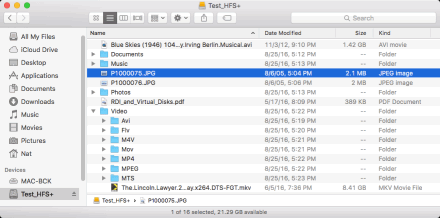
Fig.1: Files on the disk (root folder)
Click image to enlarge
The disk was erased using the Disk Utility in the macOS. Now Mac's Finder shows no files on it.
Data recovery process
Preliminary preparation:
We'll use computer's system disk to store recovered files. If you don't have enough space on yours to keep all recovered files, you may use an external disk or network drive. Do not try to save the files on the disk where the lost files resided, or you may lose them for good.
Download and install R-Studio. At this point, you don't have to immediately buy or register the program. It will run in its demo mode and perform all the necessary data recovery operations except saving the recovered files. This will allow you to estimate chances for successful data recovery. If you decide that R-Studio is worth buying you may do so and register it on-the-fly without re-installing or restarting.
Note: Our article will show the Mac version of R-Studio to illustrate the data recovery process, but this procedure will be the same for the Linux and Windows versions, except that the panels and other controls will look differently.
1. Connect the disk to the computer where R-Studio has been installed.
Tip: Use the fastest interface available to connect the disk, especially if the disk is very large. The fastest interface in Macs is Thunderbolt, followed by eSATA, USB 3.0, and FireWire. Common USB 2.0 may be too slow for large disks.
2. Start R-Studio and locate the erased disk and the disk to store the recovered files.
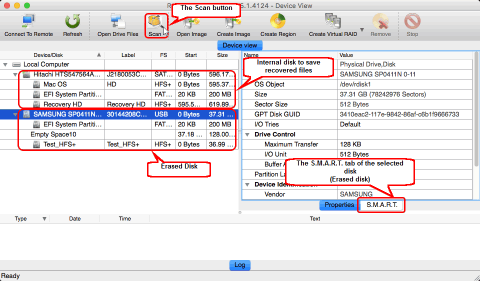
Fig.2: The erased disk in R-Studio main panel
Click image to enlarge
When we need to check the S.M.A.R.T. attributes for the erased disk:
- If the health status is CAUTION, there may be minor problems with the disk, but it should be safe to use the disk for data recovery purposes. The problems are likely to worsen, so check the S.M.A.R.T. parameters periodically to ensure that the health status hasn't gone to BAD. Creating an image of the disk is recommended, but this will require additional storage space.
- If the health status is BAD, the disk conditions are critical and chances of hardware failure are high. The best recommendation for this case is to stop working with the disk and bring it to professional data recovery specialists. You may continue to work with the disk at your own risk, but disk imaging is very strongly recommended.
If the S.M.A.R.T. attributes of the disk are OK, we may start the data recovery.
3. Select the erased disk and click the Scan button. The Scan dialog box will appear.
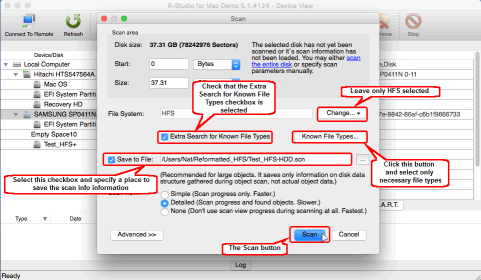
Fig.3: Disk scan dialog box for the erased HFS disk
Click image to enlarge
As the file system of the erased disk is known, we can reduce false positive detections for other file systems on the disk by limiting the file system to search for. Click the Change... button next to File Systems and leave only the HFS file system selected.
Tip: We advise you to save the results of disk scan to a file. That will help if you have to interrupt the disk scan and then resume it later. Check "Save to File" and specify a save location to save the scan information.
4. Check that the Extra search for Known File Types option is selected and click the Known File Types... button.
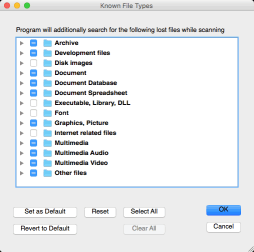
Fig.4: Known file types selected for the erased HFS disk
Click image to enlarge
Specify only those file types that may have resided on the erased disk. The best way to do that is to click the Clear button and then select the necessary types in the list. Then click the OK button and return to the Scan dialog box. Click the Scan button.
5. R-Studio will start scanning the disk showing the progress.
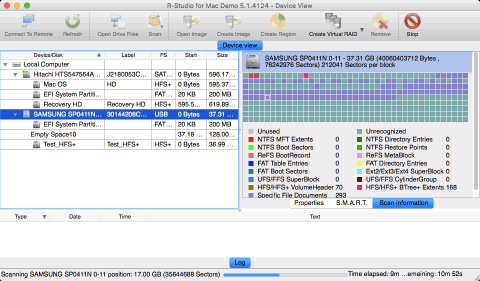
Fig.5: Disk scan in progress for the HFS disk
Click image to enlarge
6. Look at the scan results to find the recognized partition belonging to the erased disk.
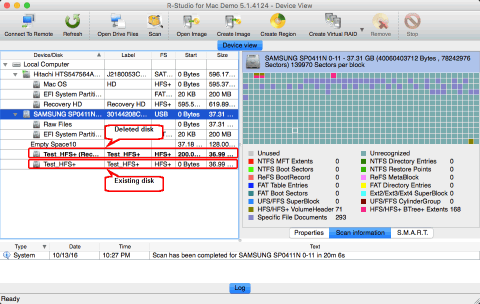
Fig.6: Scan results for the HFS disk
Click image to enlarge
In our case, this is the Recognized1 partition.
Some other partitions that previously resided on the disk may also be found. To determine the recognized partition you are looking for, look at the size and position of the recognized partitions. See R-Studio online help for more details: Data Recovery Using R-Studio.
7. Double-click the Recognized1 partition. R-Studio will enumerate the files on it and show its folder structure.
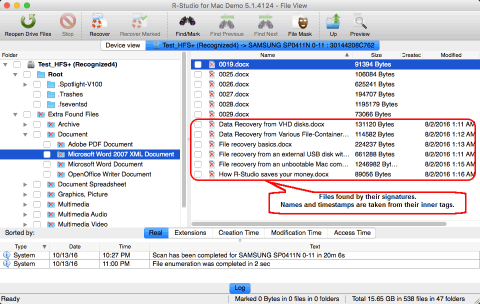
Fig.7: Files and folders found on the erased disk
Click image to enlarge
When macOS erases an HFS/HFS+ disk, it completely erases the file system on that disk. This means that the file names and folder structure are lost, but often, the underlying data is intact. In this case, R-Studio can identify the files based on their file signatures. This data recovery method is known as a "raw file recovery" or a "search for known file types". Using this method, R-Studio can restore the files, but typically cannot restore the file names and folder names or other file attributes. Some file types, such as Word documents and photos, have file tags and other metadata that R-Studio can use to recreate meaningful file names and timestamps. Otherwise, R-Studio will automatically generate a filename, such as 0256.docx.
If you are searching for a particular file or set of files, you can use the advanced find and mark capabilities of R-Studio. See R-Studio help for more details: Searching for a File.
8. Use the built-in Previewer to estimate chances for successful data recovery. This is particularly useful with large picture files. Double-click a file to preview it.
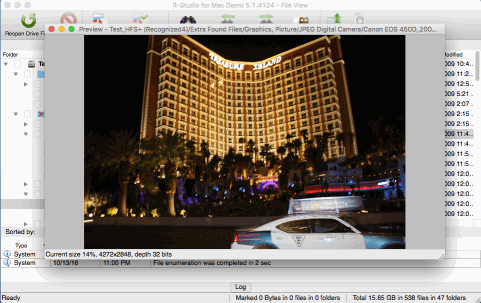
Fig.8: Preview of a photo file
Click image to enlarge
If several files appear correctly, you can purchase a license and register R-Studio. Now you may start saving recovered files.
9. Select the files and folders you want to recover and choose a place to save the recovered files.
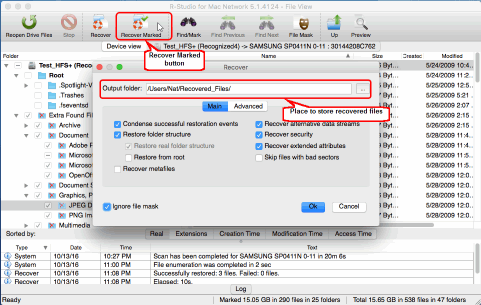
Fig.9. Files marked for recovery and recovery options
Click image to enlarge
If necessary, specify other recovery parameters. See R-Studio on-line help for details: Basic File Recovery. Then, click the Recover Marked button. If necessary, specify other recovery parameters. See R-Studio on-line help for details: Basic File Recovery. Then, click the Recover Marked button.
10. R-Studio will start recovering files showing its progress.
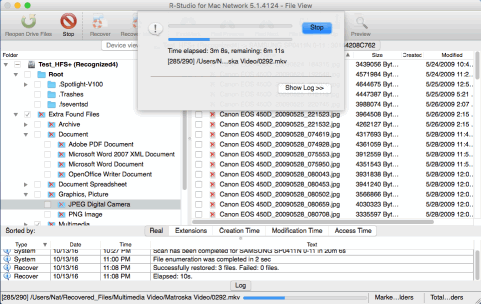
Fig.10: Recovery progress for files from erased HFS disk
Click image to enlarge
11. When R-Studio finishes recovery, it will show a final report with the results.
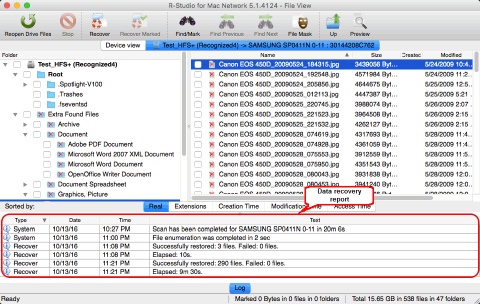
Fig.11: Data recovery results for the erased HFS disk
Click image to enlarge
Data recovery results
To view the recovered files, browse to the folder you selected in step 9 in this article.
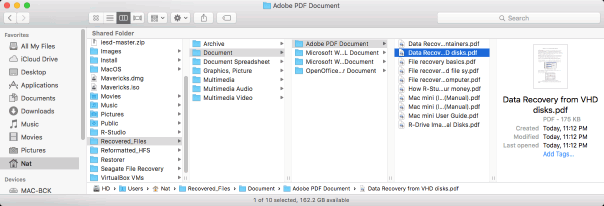
Fig.12: Data recovery results for the erased HFS disk
Click image to enlarge
Conclusions
When macOS erases an HFS/HFS+ disk , it completely deletes all traces of the file names and folder structure but leaves the content of the files intact, making the chances of recovering data very high if no new data has been written to the disk. You may test how R-Studio can do that running it in its demo mode without registration. In this mode it's fully functional and can perform all the necessary data recovery operations except saving recovered files larger than 256 KB. You may use the built-in file previewer to see if R-Studio has successfully recovered your files. If so, you can register it on-the-fly and save your files without reinstalling and re-scanning.
- R-Studio Technician: activation using a USB stick
- Data Recovery Guide
- Why R-Studio?
- R-Studio for Forensic and Data Recovery Business
- R-STUDIO Review on TopTenReviews
- File Recovery Specifics for SSD devices
- How to recover data from NVMe devices
- Predicting Success of Common Data Recovery Cases
- Recovery of Overwritten Data
- Emergency File Recovery Using R-Studio Emergency
- RAID Recovery Presentation
- R-Studio: Data recovery from a non-functional computer
- File Recovery from a Computer that Won't Boot
- Clone Disks Before File Recovery
- HD Video Recovery from SD cards
- File Recovery from an Unbootable Mac Computer
- The best way to recover files from a Mac system disk
- Data Recovery from an Encrypted Linux Disk after a System Crash
- Data Recovery from Apple Disk Images (.DMG files)
- File Recovery after Re-installing Windows
- R-Studio: Data Recovery over Network
- How To Use R-Studio Corporate Package
- Data Recovery from a Re-Formatted NTFS Disk
- Data Recovery from an ReFS disk
- Data Recovery from a Re-Formatted exFAT/FAT Disk
- Data Recovery from an Erased HFS Disk
- Data Recovery from an Erased APFS Disk
- Data Recovery from a Re-Formatted Ext2/3/4FS Disk
- Data Recovery from an XFS Disk
- Data Recovery from a Simple NAS
- How to connect virtual RAID and LVM/LDM volumes to the operating system
- Specifics of File Recovery After a Quick Format
- Data Recovery After Partition Manager Crash
- File Recovery vs. File Repair
- Data Recovery from Virtual Machines
- How to Connect Disks to a Computer
- Emergency Data Recovery over Network
- Data Recovery over the Internet
- Creating a Custom Known File Type for R-Studio
- Finding RAID parameters
- Recovering Partitions on a Damaged Disk
- NAT and Firewall Traversal for Remote Data Recovery
- Data Recovery from an External Disk with a Damaged File System
- File Recovery Basics
- Default Parameters of Software Stripe Sets (RAID 0) in Mac OS X
- Data Recovery from Virtual Hard Disk (VHD/VHDX) Files
- Data Recovery from Various File Container Formats and Encrypted Disks
- Automatic RAID Parameter Detection
- IntelligentScan Data Recovery Technology
- Multi-pass imaging in R-Studio
- Runtime Imaging in R-Studio
- Linear Imaging vs Runtime Imaging vs Multi-Pass Imaging
- USB Stabilizer Tech for unstable USB devices
- Joint work of R-Studio and PC-3000 UDMA hardware
- Joint work of R-Studio and HDDSuperClone
- R-Studio T80+ - A Professional Data Recovery and Forensic Solution for Small Business and Individuals Just for 1 USD/day
- Backup Articles
- R-Drive Image Standalone and Corporate license transferring
- Fixing Windows update error 0x80070643 with R-Drive Image
- Backup with Confidence
- R-Drive Image as a free powerful partition manager
- Computer Recovery and System Restore
- Disk Cloning and Mass System Deployment
- Accessing Individual Files or Folders on a Backed Up Disk Image
- R-Drive Image startup / bootable version
- File Backup for Personal Computers and Laptops of Home and Self-Employed Users
- Creating a Data Consistent, Space Efficient Data Backup Plan for a Small Business Server
- How to Move the Already Installed Windows from an Old HDD to a New SSD Device and Create a Hybrid Data Storage System
- How to Move an Installed Windows to a Larger Disk
- How to Move a BitLocker-Encrypted System Disk to a New Storage Device
- How to backup and restore disks on Linux and Mac computers using R-Drive Image
- Undelete Articles
- Get Deleted Files Back
- Free Recovery from SD and Memory cards
- R-Undelete: Video Recovery
- Recovery from an External Device with a Damaged File System
- File recovery from a non-functional computer
- Free File Recovery from an Android Phone Memory Card
- Free Photo and Video File Recovery Tutorial
- Easy file recovery in three steps
Rating: 5.0 / 5
I used some software for data recovery on MAC, but THIS IS only one, that help me!!!
THX :)
bye
Tom from Hungary
Needless to say a RAID0 set created using Apple`s Disk Utility was broken and formatted as a new RAID0. I immediately recognized my mistake and shut down the server.
After some web surfing and saki I found R-Studio.
After the other utilities I normally use failed, R-Studio was able to create an image of the broken (and reformatted) RAID disks.
The entire volume ...
________________________________
5+ I was able to repair my RAID-5 for Mac volume to 20 TB - it`s the best solution. I would recommend.
I would just like to thank you for an excellent product. I was able to recover nearly a terabyte of data after a raid 6 array failed. My customer was ecstatic over the results




